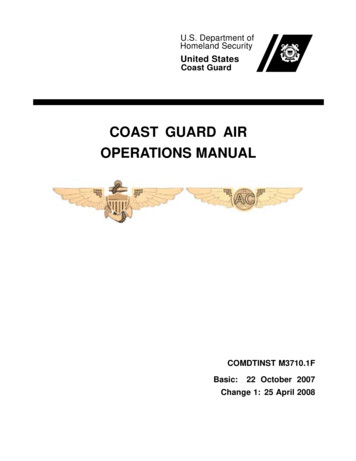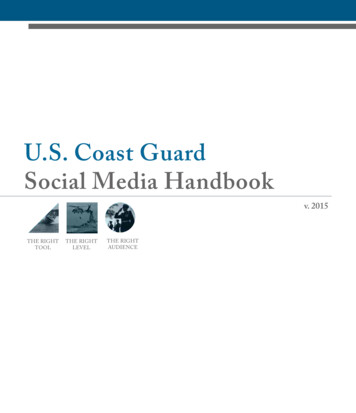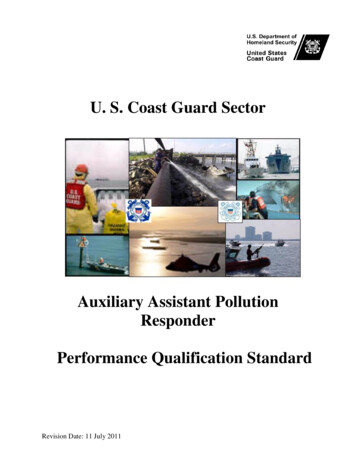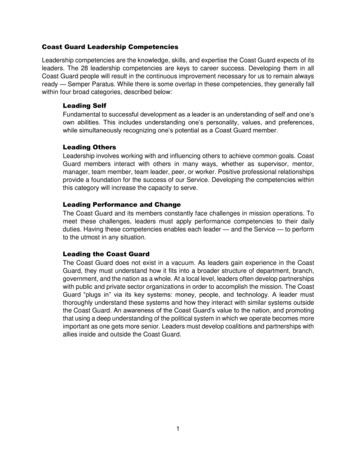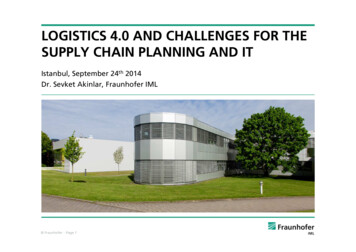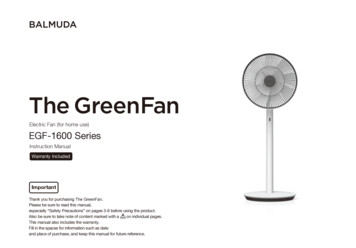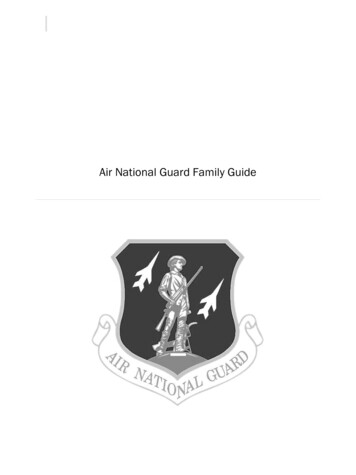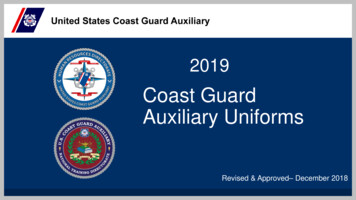
Transcription
U.S. Department ofHomeland SecurityUnited StatesCoast GuardThe Coast GuardIntegrated Logistics Support(ILS) ManualCOMDTINST M4105.14March 2018Distribution Statement A: Approved for public release. Distribution is unlimited.
COMDTINST M4105.14This page intentionally left blank.ii
CommandantUnited States Coast GuardUS Coast Guard Stop 77142703 Martin Luther King JR Ave SEWashington DC 20597-7714Staff Symbol: CG-444Phone: 202 475 5637Fax: 202 475 5955COMDTINST M4105.14March 12, 2018COMMANDANT INSTRUCTION M4105.14Subj:THE COAST GUARD INTEGRATED LOGISTICS SUPPORT (ILS) n and Life Cycle Management Manual, COMDTINST M5212.12 (series)Major Systems Acquisition Manual (MSAM) Handbook (series)Coast Guard Configuration Management Manual, COMDTINST M4130.6 (series)Diminishing Manufacturing Sources and Material Shortages (DMSMS) Manual,COMDTINST M4105.12 (series)Supply Policy and Procedures Manual (SPPM), COMDTINST M4400.19 (series)Deputy Commandant for Mission Support (DCMS) Engineering TechnicalAuthority (ETA) Policy, COMDTINST 5402.4 (series)Aeronautical Engineering Maintenance Management Manual, COMDTINSTM13020.1 (series)Provisioning Allowance and Fitting Out Support (PAFOS) Policies and ProceduresManual, NAVSEA 9090-1500Civil Engineering Manual, COMDTINST M11000.11 (series)U.S. Coast Guard Real Property Management Manual, COMDTINST M11011.11(series)1. PURPOSE. This Manual establishes policy and procedures for the practice of the ILSprocess throughout the Coast Guard.2. ACTION. All Coast Guard unit commanders, commanding officers, officers-in-charge,deputy/assistant commandants, and chiefs of headquarters staff elements must comply withthe provisions of this Manual. Internet release is authorized.DISTRIBUTION – SDL No. 168abcdefgABCDEFGHXXhijXXNON-STANDARD DISTRIBUTION:klmnopqrstuvwxyz
COMDTINST M4105.143. DIRECTIVES AFFECTED. The following directives are cancelled:a. Coast Guard Engineering Logistics Concept of Operations (ECONOP), COMDTINST4100.7 (series);b. Coast Guard Independent Logistics Assessment (ILA), COMDTINST 4081.19 (series);c. Coast Guard Logistics Readiness Review (LRR), COMDTINST 4081.3 (series);d. Provisioning Manual, COMDTINST M4423.5 (series);e. Equipment/System Integrated Logistics Support Plan (EILSP) and Equipment SupportSheet (ESS) Development and Maintenance Responsibilities, COMDTINST 4105.7(series);f. Logistics Element Manager's (LEM) Desk Guide, COMDTINST M4105.11 (series);g. Long Range Planning of Logistics Support for Operational U.S. Coast Guard Cutters,COMDTINST 4105.4 (series);h. Maintenance Management Policy, COMDTINST 4790.3 (series);i. Standardized Bar Coding within the Coast Guard for Logistics Applications,COMDTINST 4000.4A;j. System Integrated Logistics Support (SILS) Policy Manual, COMDTINST M4105.8(series); andk. U.S. Coast Guard Logistics Handbook, COMDTINST M4000.2 (series).4. DISCUSSION. This Manual defines the process applied for developing Life Cycle SupportStrategies for Coast Guard acquisitions and continuously maintaining these strategies toprovide the greatest mission success possible from available resources.5. DISCLAIMER. This guidance is not a substitute for applicable legal requirements, nor is ititself a rule. It is intended to provide guidance for Coast Guard personnel and is not intendedto nor does it impose legally binding requirements on any party outside the Coast Guard.6. MAJOR CHANGES. This Manual updates and consolidates Coast Guard ILS direction intoa single directive using a systems engineering approach. It supports the DeputyCommandant for Mission Support (DCMS) business model. It specifies requirements for asingle standard ILS plan applicable to all assets and provides more complete and emphasizedguidance on ILS activities conducted during the Produce/Deploy/Support phase of theDepartment of Homeland Security (DHS) Acquisition Life Cycle Framework.7. ENVIRONMENTAL ASPECT AND IMPACT CONSIDERATIONS.a. The development of this policy has been thoroughly reviewed by the originating office inconjunction with the Office of Environmental Management, and is categorically excluded(CE) under current United States Coast Guard (COAST GUARD) CE # 1 from furtherenvironmental analysis, in accordance with Section 2.B.2 and Figure 2-1 of the NationalEnvironmental Policy Act Implementing Procedures and Policy for ConsideringEnvironmental Impacts, COMDTINST M16475.1 (series). Because this Policy is aguidance document that implements, without substantive change, applicableCommandant Instructions and other Federal agency regulations, procedures, manuals andother guidance documents, Coast Guard categorical exclusion #33 is appropriate.2
COMDTINST M4105.14b. This directive will not have any of the following: significant cumulative impacts on thehuman environment; substantial controversy or substantial change to existingenvironmental conditions; or inconsistencies with any Federal, State, or local laws oradministrative determinations relating to the environment. All future specific actionsresulting from the general policies in this Manual must be individually evaluated forcompliance with the National Environmental Policy Act (NEPA), Council onEnvironmental Policy NEPA regulations at 40 CFR Parts 1500-1508, DHS and CoastGuard NEPA policy, and compliance with all other environmental mandates.8. DISTRIBUTION. No Paper Distribution will be made of this Manual. An electronic versionwill be located on the following Commandant (CG-612) web sites. Internet:https://www.uscg.mil/directives/ , and ives/SitePages/Home.aspx.9. RECORDS MANAGEMENT CONSIDERATIONS. This Manual has been thoroughlyreviewed by the Coast Guard, and the undersigned have determined this action requiresfurther scheduling requirements, in accordance with Federal Records Act, 44 U.S.C. 3101 etseq., National Archives and Records Administration (NARA) requirements, and Informationand Reference (a). This policy has significant or substantial change to existing recordsmanagement requirements, or inconsistencies with existing determinations relating todocumentation requirements.10. ROLES AND RESPONSIBILITIES. The technical warrant holder governing the ILS policyis the Office of Logistics, responsible for:a. Changes to the ILS policy and this Manual; and,b. Support to Coast Guard ILS process users.11. FORMS/REPORTS. None.12. REQUEST FOR CHANGES. Recommendations for changes and improvements to thisManual must be submitted via the chain of command to the CM Division, Commandant(CG-444).Melvin W. Bouboulis /s/Rear Admiral, U.S. Coast GuardAssistant Commandant for Engineering andLogistics3
COMDTINST M4105.14RECORD OF CHANGESCHANGENUMBERDATE OFCHANGEDATE ENTEREDBY WHOMENTERED
COMDTINST M4105.14TABLE OF CONTENTSCHAPTER 1. INTRODUCTION.1-1A. Purpose1-1B.How this Manual is Organized1-1C.Integrated Logistics Support in the Asset Life Cycle1-21.2.3.4.ILS Process Concept of Operations (CONOPS)Key Concepts and DefinitionsILS Process ObjectivesILS Process Roles and Responsibilities1-21-31-61-6D. Relationship of the ILS Process to Other Functions1-101. The ILS Process and Engineering2. The ILS Process and Acquisition3. The ILS Process and Mission Support Directorates (LogisticsSupport Providers)4. The ILS Process and Human Resources5. The ILS Process and Sponsor Organizations1-111-12ILS Process Overview1-121. ILS Management2. Life Cycle Support Planning3. Practice Sustaining Engineering1-131-131-13ILS Process Best Practices1-13G. ILS Training and Certification1-14E.F.CHAPTER 2. ILS PROCESS TAILORING1-121-121-122-1A. Tailoring Requirements2-1B.Tailoring Responsibility2-1C.Tailoring Considerations2-2CHAPTER 3. ILS MANAGEMENT3-1A. Scope3-1B.Assumptions3-1C.Entrance Criteria3-1D. Logistics Master Schedule -13-13-13-3i
COMDTINST M4105.14E.F.ILS Budgeting and vitiesOutputsConfiguration Management iesOutputsG. Performance-based Logistics -83-83-83-9H. Logistics esOutputs3-93-93-103-11Diminishing Manufacturing Sources and Material Shortages(DMSMS) tputs3-113-123-133-15Transition tsActivitiesOutputsK. Exit Criteria3-20CHAPTER 4. PRACTICE SUSTAINING ENGINEERING4-1A. Scope4-1B.Assumptions4-1C.Entrance Criteria4-1D. Monitor and Analyze Support Program Performance1. Discussion4-14-1ii
COMDTINST M4105.142. Inputs3. Activities4. Outputs4-14-14-6Exit Criteria4-6CHAPTER 5. LIFE CYCLE SUPPORT PLANNING5-1E.A. Scope5-1B.Assumptions5-1C.Entrance Criteria5-1D. Evaluate the Maintenance Planning and Management ts5-15-35-45-17Evaluate Supply Support sActivitiesOutputsEvaluate the Technical Data sActivitiesOutputsG. Evaluate Packaging, Handling, Storage, and Transportation(PHS&T) 2.3.4.5-345-345-355-355-41H. Evaluate Support Equipment 415-425-425-44Evaluate the Manpower and Personnel Element5-441. Discussion2. Inputs3. Activities5-445-455-45iii
COMDTINST M4105.14J.4. Outputs5-46Evaluate the Training & Training Support sActivitiesOutputsK. Evaluate Facilities and Infrastructure 5-505-505-515-515-53Evaluate the Computer Resources sActivitiesOutputsM. Evaluate Design Interface 565-565-575-575-64N. Exit Criteria5-64LIST OF TABLESTable 3-1:Table 3-2:Table 5-1:Table 5-2:Table 5-3:Table 5-4:Table 5-5:Configuration Management Process ComponentsAsset Disposal ReferencesRange of Maintenance ApproachesProvisioning Guidance Conference TypesTraining TypesTraining Approaches and TechniquesProgrammatic Environment, Safety, and Occupational Health Evaluation(PESCHE) Data Requirements3-63-195-25-215-475-475-61LIST OF FIGURESFigure 1-1:Figure 1-2:Figure 1-3:Figure 1-4:Figure 1-5:Figure 5-1:ILS Process Concept of Operations (CONOPS)Logistics Support Provider SchematicILS Process Resources FlowLife Cycle Cost (LCC) DistributionILS Process OverviewReliability Centered Maintenance (RCM) Sub Processes and Level Of RepairAnalysis (LORA)Figure 5-2. Reliability Centered Maintenance (RCM) Decision Logic Treeiv1-21-91-111-121-135-85-10
COMDTINST M4105.14APPENDICESAPPENDIX A LIST OF ACRONYMSAPPENDIX B GLOSSARYAPPENDIX C INDEPENDENT LOGISTICS ASSESSMENT (ILA) CRITERIAA. ScopeB Explanation of Letter CodesAPPENDIX D LOGISTICS READINESS REVIEW (LRR) CRITERIAvA-1B-1C-1C-1C-1D-1
COMDTINST M4105.14CHAPTER 1. INTRODUCTION.A.Purpose.The purpose of Integrated Logistics Support (ILS) is to identify the optimal Life CycleSupport Strategy for maintaining a Coast Guard asset. The term “Coast Guard asset”applies to Coast Guard systems and equipment such as cutters, boats, aircraft, informationtechnology systems, communications systems, electronics systems, aids to navigation,shore facilities, and components.This Manual establishes ILS policy and communicates the ILS process to be applied whendeveloping, monitoring, and maintaining Life Cycle Support Strategies for Coast Guardassets. All acquisition Program Managers (PMs) and Product Line Managers (PLMs) mustapply the ILS process described in this Manual. This process must be applied to the levelnecessary to ensure all Coast Guard assets provide known and expected functionality,availability, and readiness with known risk levels and managed Total Ownership Cost(TOC) throughout the asset's life cycle.This Manual works hand-in-hand with the MSAM, NMAP Manual, and DHS Guidebook102-01-103-01, Systems Engineering Guidebook. It amplifies and further defines the lifecycle support strategy requirements defined therein.B.How this Manual is Organized.1. CHAPTER 1 INTRODUCTION. This Chapter provides a high-level view of thepurpose of Coast Guard ILS and how it relates to other Coast Guard functions. It alsoprovides an overview of Coast Guard ILS process flow.2. CHAPTER 2 ILS PROCESS TAILORING. This Chapter provides guidance ontailoring the Coast Guard ILS Process for varying program and asset scopes.3. CHAPTER 3 ILS MANAGEMENT. This Chapter explains the tasks involved inmanaging the ILS process overall throughout the life of an asset.4. CHAPTER 4 PRACTICE SUSTAINING ENGINEERING. This Chapter explains thetasks involved in monitoring and adjusting support programs to accommodate changes,ensure compliance with supportability requirements, and minimize TOC.5. CHAPTER 5 LIFE CYCLE SUPPORT PLANNING. This Chapter explains theprocess of analyzing the ILS elements to develop and mature the Life Cycle SupportStrategy.6. APPENDIX A LIST OF ACRONYMS. This Chapter explains the meaning ofacronyms used in this Manual.7. APPENDIX B GLOSSARY. The Chapter provides definitions for selected terms usedin this Manual.8. APPENDIX C INDEPENDENT LOGISTICS ASSESSMENT (ILA) CRITERIA. ThisAppendix contains a checklist of criteria that may be used to conduct ILAs.1-1
COMDTINST M4105.149. APPENDIX D LOGISTICS READINESS REVIEW (LRR) CRITERIA. ThisAppendix contains a checklist of criteria that may be used to conduct LRRs.C.Integrated Logistics Support in the Asset Life Cycle.1.ILS Process Concept of Operations (CONOPS).The ILS process CONOPS is depicted and explained in Figure 1-1. ILS is derivedfrom the systems engineering process where Life Cycle Support activities are designedto achieve operational availability thresholds and maximize use of existing CoastGuard logistics infrastructure. ILS implements tasks necessary to deliver readiness,affordably. Like a sailing master setting sails to make the most of the available wind,ILS steers and drives our logistics infrastructure (Acquisition, Logistics Centers,Service Centers, Bases, Other Government Agencies (OGAs) and Contractors) inresponse to mission & TrainingSupportComputerResourcesManpower andPersonnelSupplySupportPackaging,Handling, Storage,and Planning structureLCIProduce Deploy/SupportFigure 1-1: ILS Process Concept of Operations (CONOPS)The ILS Manager, assisted by the Integrated Logistics Support Management Team(ILSMT), designs the Life Cycle Support Strategy by analyzing and balancing the ILSelements in context with ILS Management principles. They produce the ILS productsnecessary to deliver the designed support while maximizing use of existing CoastGuard logistics infrastructure when that is the optimal lowest life cycle cost choice.They validate and verify the program through Independent Logistics Assessment(ILAs) and Logistics Readiness Review (LRR), then monitor its implementation andadjust the strategy throughout the life cycle via the Sustaining Engineering elementand Logistics Compliance Inspections (LCIs).1-2Disposal
COMDTINST M4105.142.Key Concepts and Definitions.a.The ILS Process. The ILS process is a deliberate, unified, and iterativemethodology applied to continuously develop a Life Cycle Support Strategy,documented in an ILSP, that:(1) Optimizes functional support elements for a system within the constraints of:(a)Coast Guard operational capabilities;(b)Funding;(c)Contractor logistics capabilities;(d)Coast Guard support capabilities;(e)New technologies;(f)Operational requirements; and,(g)OGA support capabilities.(2) Leverages existing investments in manpower, systems, equipment, training,facilities, and other resources;(3) Guides the system engineering process to minimize TOC usingsupportability attributes to achieve goals and to:(a)Identify the support requirements (design the support and support thedesign);(b)Influence the best design alternative;(c)Refine ILS guidance;(d)Influence Test and Evaluation (T&E) of both the system and theplanned Life Cycle Support Strategy;(e)Resource and acquire the requisite support;(f)Provide the support to Coast Guard personnel; and,(g)Improve the support throughout the asset’s life cycle.(4) Ensures interoperability of materiel within the Coast Guard, DHS,Department of Defense (DoD) and coalition partners.(5) The ILS Process is not the process of creating an ILSP: an ILSP is a livingdocument that documents the logistics support.b.Life Cycle Support Strategy and the ILS Plan (ILSP).A Life Cycle Support Strategy is the managed set of official Coast Guardrequirements that specifies and optimally allocates an asset's support requirementsamong Logistics Support Providers. The ILSP is a document that presents theserequirements. This distinction is important: where this Manual refers to“updating the ILSP” the intent is to update the requirements at the point wheretheir configuration is controlled, whether that be in a requirements management1-3
COMDTINST M4105.14tool, a database, or some other repository, not merely updating the document inwhich the requirements are presented.Each Coast Guard asset (cutter, boat, aircraft, information technology system,electronics system, facility, etc.) must develop and maintain a Life Cycle SupportStrategy and document it in an ILSP.(1) The Life Cycle Support Strategy must consist of all life cycle supportrequirements.(2) Life Cycle Support Strategies for Coast Guard assets must address the ILSelements defined in this Manual.(3) Life Cycle Support Strategy requirements must be outcome-based: theymust be constructed to provide the best-value approach to achieving themission outcomes required by Coast Guard at the lowest TOC.(4) Life Cycle Support Strategy requirements must not unduly constrain theimplementation options of Logistics Support Providers.(5) At minimum, the Integrated Logistics Support Manager (ILSM) must ensurethat the ILSP is reviewed annually and updated as needed.(6) The outline and requirements provided in Reference (b)’s ILSP templatedocument the required logistic support information and guide ILSPdevelopment.(7) Since Life Cycle Support Strategies are subject to change, ILSPs are livingdocuments. The PM/ILSM and the ILSMT are responsible for creating andmaintaining the ILSP. After the ILSP foundation is built, the strategy’srefinement continues to rely on, influence, and interface with other analysesand acquisition planning efforts (e.g., Analysis of Alternatives (AA),Operational Requirements Document (ORD), and Life Cycle Cost Estimate(LCCE)). These mutually supportive relationships begin early, remaincritical throughout acquisition, and are essential for successful supportabilityand sustainment planning and execution. Although an ILSP will be updatedthroughout the acquisition life cycle to improve detail and fidelity, thisstrategy refinement must be part of the planning effort and not lagimplementation.c.ILS Elements. The ILS process analyzes life cycle support from 12 interrelateddisciplines, called "elements". These elements are described below. Eachelement describes a key perspective on asset support:(1) ILS Management. The discipline of managing the ILS process and the LifeCycle Support Strategy throughout the life cycle of the asset and balancingthe other elements to adapt to changing conditions. ILS Management is theresponsibility of the asset’s ILSM;(2) Design Interface. The practice of interpreting and feeding-back supportconsiderations into the asset design process to account for and enhance thesupportability and affordability of the design;1-4
COMDTINST M4105.14(3) Sustaining Engineering. The discipline of monitoring and measuringlogistics support throughout the asset’s life cycle to continuously adapt andadjust the Life Cycle Support Strategy to optimize performance;(4) Maintenance Planning and Management. The discipline of identifying,assigning, and communicating necessary maintenance tasks;(5) Manpower and Personnel. The discipline of identifying, assigning, andcommunicating the manpower and personnel required to deliver requiredoperational availability;(6) Facilities and Infrastructure. The discipline of identifying, assigning, andcommunicating the fixed assets required to deliver required operationalavailability;(7) Computer Resources. The discipline of identifying, assigning, andcommunicating the information technology required to deliver requiredoperational availability;(8) Technical Data. The discipline of identifying, assigning, and communicatingthe technical data required to deliver required operational availability;(9) Training and Training Support. The discipline of identifying, assigning, andcommunicating the training assets required to deliver required operationalavailability;(10) Supply Support. The discipline of identifying, assigning, andcommunicating the flow of materiel (e.g., consumables, spare parts, etc.)required to meet the asset’s maintenance requirements;(11) Packaging, Handling, Storage, and Transportation (PHS&T). The disciplineof identifying, assigning, and communicating requirements for safeguardingmateriel and supplies; and(12) Support Equipment. The discipline of identifying, assigning, andcommunicating any additional assets required to deliver required operationalavailability.ILS Management and Sustaining Engineering. These activities manage andleverage the other ILS elements.d.Total Ownership Cost (TOC) and Operational Availability (AO)/AvailabilityIndex (AI). TOC and AO/AI are two key evaluation factors for ILS programs.The overall goal of ILS is to provide the required asset availability at the lowestTOC.(1) TOC includes all costs associated with the research, development,procurement, operation, logistics support, and disposal of an asset. Itincludes the total supporting infrastructure that plans, manages, and operatesthe asset over its full life.(2) Availability (AO) (or, for aviation assets, the Availability Index (AI)) is theKey Performance Parameter (KPP) for Sustainment. AO/AI are measures of1-5
COMDTINST M4105.14the probability that an asset, when used under stated conditions in an actualoperational environment, will operate satisfactorily when called upon. 1 ThisManual addresses AO and AI as functionally equivalent measures ofAvailability for their respective communities. Except for the paragraphsdescribing how these metrics are calculated, throughout this Manual the term“AO” implies “AI” when working with Aviation assets.3.4.ILS Process Objectives. The ILS process provides a management framework andtechnical activities needed to define and maintain Life Cycle Support Strategies todeliver the right support to the right place at the right time, at a cost the Coast Guardcan afford, despite changing environments, mission requirements, and emergentnational needs. The ILS process must:a.Influence the operational and materiel requirements/capabilities, systemperformance specifications, integration of sustainability and maintainability, andthe ultimate design or selection of a materiel system;b.Emphasize supportability early in the system life cycle;c.Provide best value product support to optimize system operational effectiveness;d.Obtain readiness and TOC improvements in the materiel system and supportsystems throughout the operational life cycle;e.Define the product support requirements best related to system design and to eachother;f.Increase availability by applying systems engineering to right-size the logisticsfootprint, optimize Mean Logistics Delay Time (MLDT), and influence systemdesign to increase Inherent Availability (Ai) 2;g.Maximize the use of existing Coast Guard or DoD logistics support resources toprovide as much commonality as practicable and to minimize new ILSrequirements and TOC;h.Develop supportable and maintainable assets within existing Coast Guardpersonnel constraints; and,i.Maintain configuration control of all ILSMT-managed data.ILS Process Roles and Responsibilities.a.Integrated Logistics Support Manager (ILSM). The ILSM:(1) Reports to the PM;1AO and AI are further discussed in the Practice Sustaining Engineering discussion in Chapter 4.D and the EvaluateDesign Interface Element discussion in Chapter 5.M.2Inherent Availability (Ai) is a measure of the theoretical Availability characteristics of an asset design and is notinterchangeable with the Availability Index (AI) used in the Aviation community. Ai is discussed further in Chapter5.M.1-6
COMDTINST M4105.14(2) Is responsible for developing and managing a comprehensive, outcomebased asset Life Cycle Support Strategy from program approval to disposal;(3) Under direction of the PM, plans and coordinates ILS program budget incompliance with Commandant guidance and policy;(4) Is responsible for preparing the Integrated Logistics Support Plan (ILSP) inresponse to changing needs and constraints throughout the asset life cycleand chairs the ILSMT;(5) Validates the LCCE against actual costs and performs periodic Life CycleSupport Strategy reviews. Assesses and adjusts resource allocations andperformance requirements for asset support not less than annually to meetCoast Guard operational needs and optimize the asset support program;(6) Is responsible for ongoing staffing and Integrated Product Team (IPT)training of the ILSMT throughout the asset's life cycle;(7) Must coordinate with the Asset Project Office (APO) as needed to facilitatetransferring support responsibility between acquisition teams and LogisticsSupport Providers;(8) Provides asset support subject matter expertise to the PM or PLM;(9) Promotes opportunities to maximize competition while meeting the objectiveof best-value, long-term outcomes to Coast Guard mission fulfillment;(10) Seeks to leverage enterprise opportunities across programs, DHS, and DoDcomponents; and,(11) Uses analytical tools and conducts cost analyses including LCCEs to selectthe preferred Life Cycle Support Strategy.b.ILS Management Team (ILSMT) and Logistics Element Managers (LEMs).(1) An ILSMT must be chartered for each asset. The ILSMT is a crossfunctional team that operates throughout the life cycle of an asset. AllILSMTs must meet at least annually throughout the life of the system.Membership of the ILSMT must be subject to change throughout the assetlife cycle in response to changing requirements. Technical AuthorityRepresentatives from the Assistant Commandant for Command, Control,Communications, Computers, and Information Technology (C4IT), AssistantCommandant for Engineering and Logistics, and the Assistant Commandantfor Human Resources are permanent members of the ILSMT. The ILSMTassist the ILSM by:(a)Assisting in Life Cycle Support Strategy and ILSP development;(b) Decomposing high-level support requirements;(c)Ensuring that the required analyses are performed and estimatescreated;(d) Developing logistics source selection criteria;1-7
COMDTINST M4105.14(e)Assisting in root cause analysis of instances where KPPs/Key SystemAttributes (KSAs); are not met; and(f)Assisting in correcting Life Cycle Support Strategy shortcomings.(2) The acquisition PM must ensure that ILSMT representative(s) participate inT&E planning and are responsible for the planning of supportabilityassessments. ILSMT representatives should develop logistics T&Eobjectives for each acquisition phase and ensure that these are incorporatedinto the formal test programs.(3) LEMs are appointed to focus on and be responsible for analyzing,developing, and monitoring asset support from the viewpoint of one or morelogistics elements. Support needs are known most intimately by those whoprovide support. Whenever possible, LEMs should be selected from thesupport organization that will eventually support the fielded asset. EachLogistics Support Provider organization must take ownership andresponsibility for their specific logistics elements and the LEMs must beempowered to speak for their command/office.(4) ILSMTs may also include Subject Matter Experts (SMEs) in areas specific tothe acquisition. SMEs may address more than one area and may fulfill otherILSMT roles. These areas may include:(a) Industry (Shipbuilder/Aerospace);(b) Research & Development Center Acquisition Support & Analysis;(c) Acquisition Logistics Programs;(d) Technical Data Management;(e) HSI;(f)Naval Engineering Support;(g) Civil Engineering;(h) Aeronautical Engineering;(i)Supply Support;(j)Sponsor’s Representation;(k) Acquisition Support;(l)Configuration Management (CM);(m) C4IT Support;(n) Legal Counsel;(o) CM Policy Support;(p) Communication Systems Support; and(q) Satellite and Networks Engineering.1-8
COMDTINST M4105.14c.Logistics Support Providers. Logistics Support Providers are those who providesupport directly to Coast Guard operations. Under the Deputy Commandant forMission Support (DCMS), they establish the standard procedures for providingsupport for each Coast Guard system (cutter, boat, aircraft, informationtechnology system, electronics system, etc.) as needed to meet the requirements ofthe asset’s approved ILSP. Key elements of this organization are shown in Figure1-2 and briefly described below. For complete, detailed, up-to-date informationabout DCMS, consult The Coast Guard Mission Support Handbook (series).Mission SupportHeadquartersDirector of OperationalLogistics uctLineManageBasesTechnical gisticsSupportCoast Guard UnitsFigure 1-2: Logistics Support Provider Schematic(1) Headquarters directorates are the technical authorities for their respectivemission support communities (e.g., Human
f. Logistics Element Manager's (LEM) Desk Guide, COMDTINST M4105.11 (series); g. Long Range Planning of Logistics Support for Operational U.S. Coast Guard Cutters, COMDTINST 4105.4 (series); h. Maintenance Management Policy, COMDTINST 4790.3 (series); i. Standardized Bar Coding within the Coast Guard for Logistics Applications, COMDTINST 4000 .


